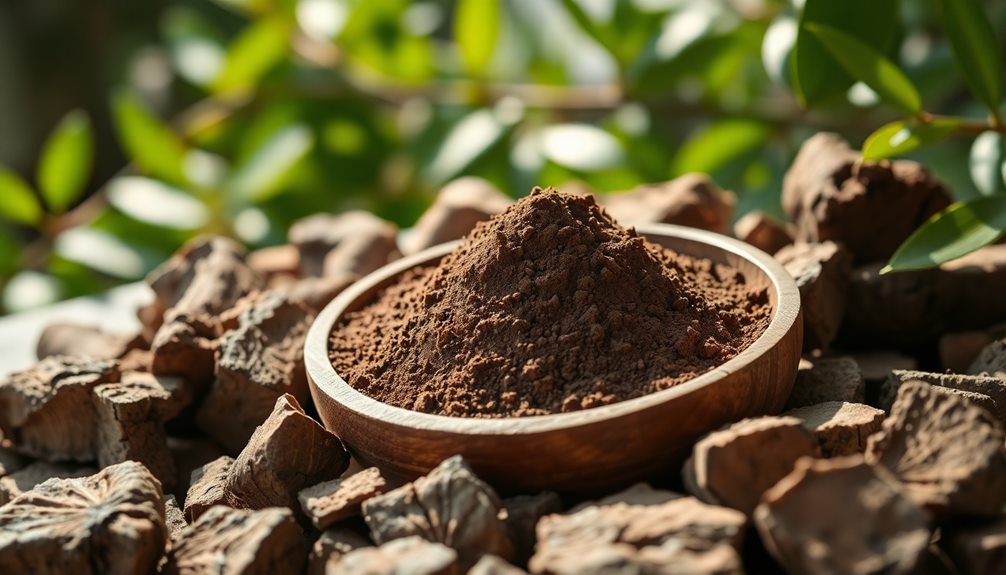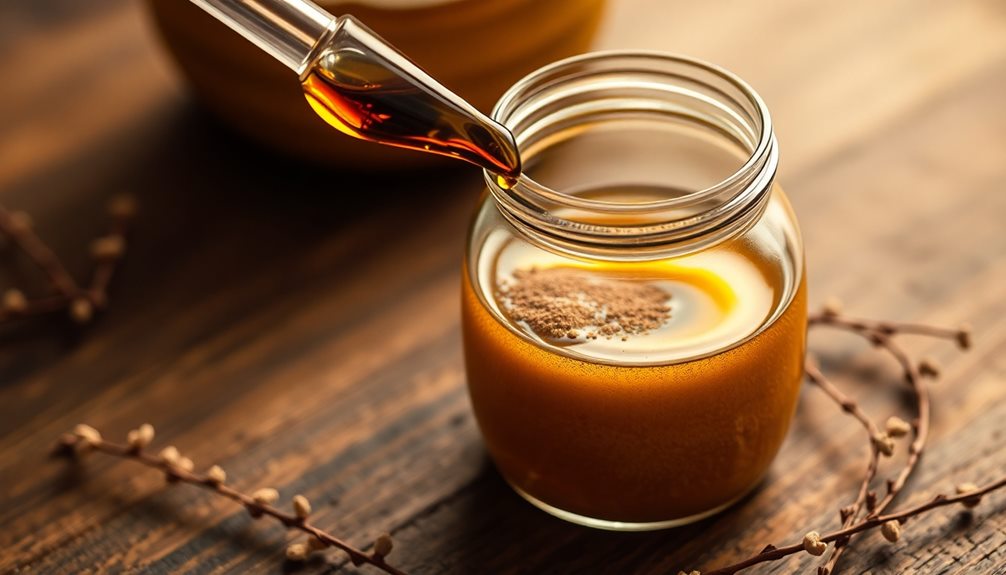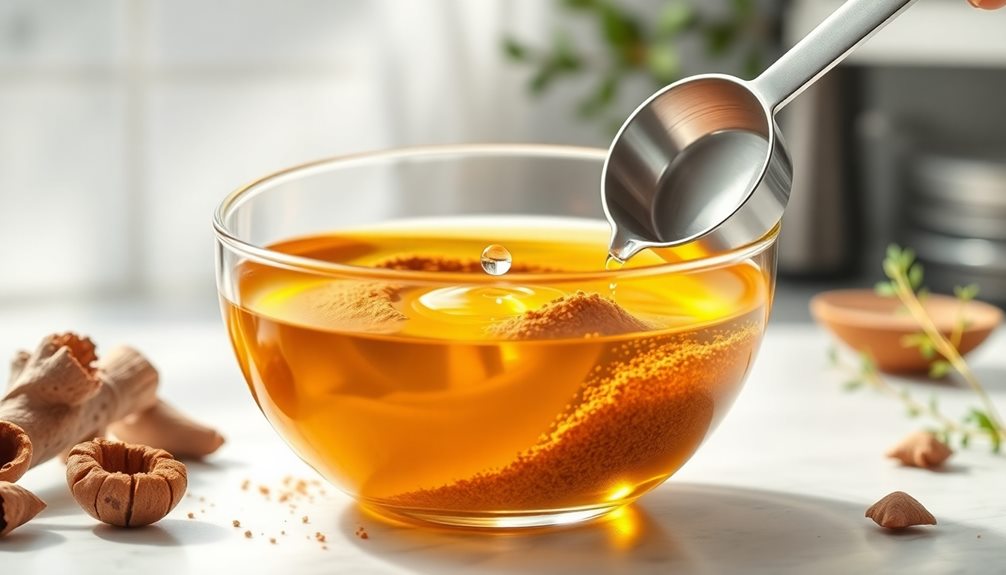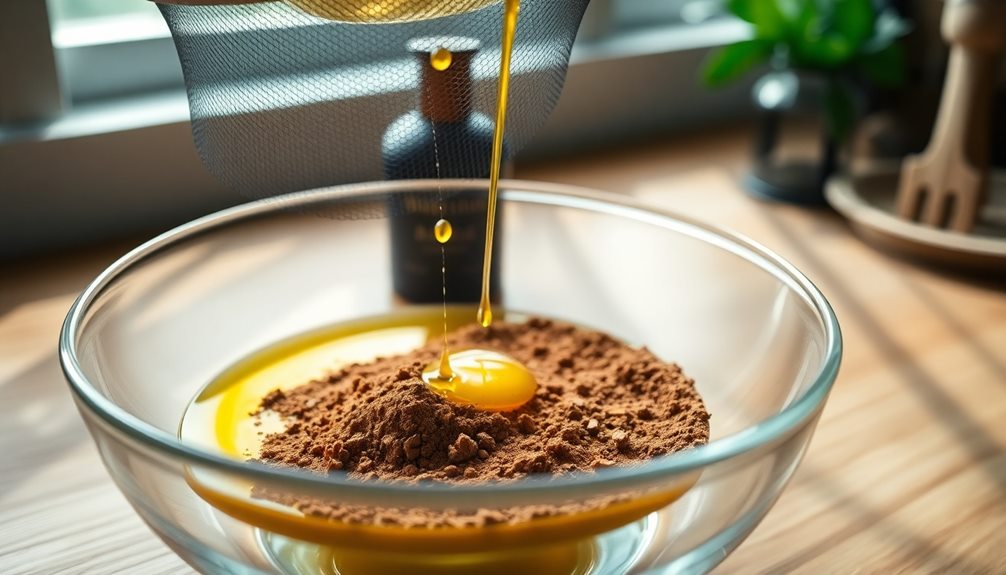Creating aloeswood incense at home offers a calming retreat for your senses. Start with equal parts of finely ground aloeswood and makko powder, ensuring thorough blending for a balanced burn. Gradually add water to achieve a dough-like consistency, mixing well without oversaturating. Sift the mixture to remove larger particles for a smoother texture. You might also consider enhancing the scent with inviting essential oils like bergamot or chamomile. This fragrant process not only uplifts your environment but also connects you to ancient traditions. Discover additional tips and adjustments for a perfectly customized incense experience that suits your unique preferences.
Summary
- Combine equal parts aloeswood powder and makko powder for a well-burning incense blend.
- Gradually add water to achieve a dough-like consistency, ensuring the mixture holds together.
- Sift the ingredients to remove larger particles, enhancing the blend's texture and burning quality.
- Incorporate essential oils, like bergamot or chamomile, to enhance the incense's aromatic and calming properties.
- Form the mixture into sticks or cones, allowing them to dry completely before use for optimal fragrance release.
Aromatherapy Stress Relief
Aromatherapy, with its enchanting scents, has long been celebrated for its ability to soothe the mind and body. When you light aloeswood incense, you're not just filling your space with a mesmerizing aroma; you're inviting a wave of tranquility into your life.
The benefits of aloeswood, similar to those of agarwood essential oil, extend beyond pleasant fragrance; its rich, earthy scent promotes relaxation, reduces anxiety, and enhances meditation practices.
To harness these benefits, you might want to learn how to make incense at home. Start by combining finely ground aloeswood powder with a natural binding agent, like makko powder. Gradually add water until you achieve a dough-like consistency.
Shape the mixture into sticks or cones, then let them dry in a cool, dry place for several days. Once dried, your homemade aloeswood incense will be ready to ignite.
As you burn it, take deep breaths and allow the calming aroma to wash over you. Whether you're unwinding after a hectic day or creating a serene atmosphere for yoga, aloeswood incense will elevate your self-care routine and foster a peaceful mindset.
Embrace the soothing power of aromatherapy and let the stress melt away.
Agarwood's Value Exceeds Gold
The allure of agarwood lies not only in its enchanting fragrance but also in its astonishing value, which often exceeds that of gold. This precious wood, also known as aloeswood, is created when the Aquilaria tree experiences a fungal infection, resulting in the formation of a dense, aromatic resin. The rarity of high-quality agarwood contributes considerably to its staggering price, sometimes reaching thousands of dollars per kilogram.
In addition to its alluring scent, incorporating elements like Unlock Relaxation through essential oils can enhance the overall aromatic experience, adding therapeutic benefits to your environment.
When you investigate the world of aloeswood incense products, you'll find an array of options, each reflecting a unique story tied to its geographical origin. From the sweet notes of Thai rakoku to the bitter nuances of Vietnamese kyara, the diverse characteristics make each variety desirable.
Not only is agarwood revered in spiritual practices, but its use in luxurious perfumes and traditional medicines underscores its cultural significance.
As you explore the aloeswood price, keep in mind that genuine products are often accompanied by certification of their quality and source. This guarantees that you're investing in something truly special, a fragrant treasure that transcends mere value and offers a deep connection to the earth.
Agarwood Incense Creation Guide
Agarwood Incense Creation Guide
Agarwood essential oil, derived from the highly prized Aloeswood, captures the warm, woody aroma that has made it a coveted ingredient in perfumery and aromatherapy. This essential oil is known for its calming properties, similar to the benefits of unlocking calm with Australian Sandalwood.
The process of creating your own Agarwood essential oil allows you to harness the unique qualities of this precious wood while guaranteeing a personal touch in the fragrance. This essential oil can be used in diffusers, added to bath products, or blended into your favorite skincare formulations for a luxurious scent experience.
Crafting Agarwood essential oil requires patience and attention to detail, as the extraction process is intricate. The oil can be produced through steam distillation or solvent extraction, but for personal use, a simple infusion method can yield delightful results. By infusing Aloeswood into a carrier oil, you can create a fragrant oil that embodies the rich, woody notes of Agarwood without the complexities of distillation.
Ingredients:
- 1 cup carrier oil (such as jojoba, sweet almond, or fractionated coconut oil)
- 2 tablespoons finely ground Aloeswood powder
- Optional: 5-10 drops of a complementary essential oil (like sandalwood or frankincense)
Instructions:
In a heat-safe glass jar, combine the carrier oil and finely ground Aloeswood powder.
Place the jar in a double boiler and gently heat the mixture for about 2-4 hours, allowing the oil to absorb the aromatic compounds from the wood.
Stir occasionally to guarantee even infusion. After the heating process, strain the oil through a fine mesh strainer or cheesecloth to remove the solids.
Store the infused Agarwood oil in a dark glass bottle to protect it from light and extend its shelf life.
Extra Tips:
When creating your Agarwood essential oil, consider using high-quality Aloeswood powder to enhance the fragrance's depth.
The infusion time can be adjusted based on your desired potency; longer infusion times will yield a stronger aroma.
Additionally, make sure to store the infused oil in a cool, dark place to maintain its therapeutic properties and fragrance.
If you wish to experiment with blending, start with small amounts of complementary essential oils to achieve your preferred scent profile.
Mix Ingredients Thoroughly
Once you've gathered your ingredients for crafting your own Aloeswood incense, it's time to focus on mixing them thoroughly. This step is vital, as it guarantees your incense burns evenly and releases the beautiful aroma you're aiming for.
The right blending techniques can enhance the aromatic experience, similar to how harnessing allspice can create a warm, inviting atmosphere. Start by combining the aloeswood powder and the makko powder in a clean bowl.
Here's how to mix them effectively:
- Measure: Use equal parts of aloeswood powder and makko powder. This balance is fundamental for a good burn.
- Blend: Use your fingers or a spoon to mix the powders until they're homogenous. You want every bit of aloeswood to be complemented by the binding qualities of the makko.
- Add Water: Gradually sprinkle in water while mixing, aiming for a dough-like consistency. Be careful not to add too much at once; you want the mixture to hold together without being overly wet.
Following these incense making instructions will lead you to a well-prepared blend.
Once mixed thoroughly, you'll be ready to shape your incense and enjoy the calming process of creating your own aromatic experience.
Step 1. Select High-Quality Aloeswood

When crafting your own Aloeswood incense, selecting high-quality Aloeswood is essential for achieving the best aromatic experience.
You'll want to take into account several aloeswood quality factors, including the geographical source, species of the Aquilaria tree, and the age of the wood. For instance, Kyara from Vietnam is renowned for its premium quality.
It's important to choose from high-quality incense brands that prioritize ethical sourcing and authenticity. Brands like Nippon Kodo and Baieido offer a range of Aloeswood incense, ensuring you receive genuine products that enhance your experience.
Be cautious of aloeswood fraud concerns, as the high value of this aromatic material can lead to counterfeit products on the market.
Always seek reputable sources that provide transparency regarding their sourcing practices. Look for brands that can verify their Aloeswood's origin, ensuring you're investing in a product that reflects its true worth.
Step 2. Choose Your Preferred Fragrance

Selecting the right fragrance for your Aloeswood incense can elevate your sensory experience to new heights. The beauty of crafting your incense lies in personalizing the aroma to match your preferences. By incorporating different natural incense ingredients, you can create a unique blend that resonates with you.
For instance, bergamot essential oil, known for its uplifting and calming properties, can enhance your incense blend by providing an invigorating, citrusy aroma that may help reduce stress and improve mood revitalize your mood.
Here are some aloeswood incense recommendations to contemplate for your recipe:
- Citrus Zest: Adding essential oils like lemon or bergamot can provide an invigorating and uplifting aroma, perfect for energizing your space.
- Floral Essence: Incorporate oils like lavender or rose for a soothing and calming effect, ideal for meditation or relaxation.
- Spicy Notes: Contemplate including oils such as cinnamon or clove, which can add warmth and depth, creating a comforting atmosphere.
Experimenting with these fragrances allows you to customize your incense recipe.
Remember, the key is to balance the scents while using high-quality natural ingredients. With a little creativity, you'll craft an aloeswood incense that not only fills your space with delightful aromas but also enhances your overall well-being.
Enjoy the journey of fragrance exploration!
Step 3. Add Binding Agent Carefully

The binding agent plays an essential role in the creation of your Aloeswood incense, ensuring that your aromatic blend holds together and burns evenly. For a beautiful, effective DIY aloeswood incense, you'll want to use a natural binding agent like makko powder, which complements the rich, woody aroma of aloeswood.
Additionally, incorporating a few drops of Balsam essential oil can enhance the soothing qualities of your incense, promoting emotional balance and relaxation during your rituals.
Begin by measuring equal parts of aloeswood powder and your chosen binding agent. Carefully mix them in a bowl, appreciating the earthy fragrance that fills the air. This step is vital, as the binding agent not only aids in forming the incense but also influences how it burns, allowing for a smoother, more consistent release of aroma.
As you create your incense, remember to follow the instructions for shaping and drying. Once your incense sticks or cones are formed, place them in a cool, dry area to harden.
After they've dried thoroughly, you can use some incense storage tips: store them in an airtight container to protect their delicate scent and keep them fresh for your future rituals or moments of relaxation.
Enjoy the soothing experience of your homemade aloeswood incense!
Step 4. Add Water for Consistency

Achieving the perfect consistency in your Aloeswood incense mixture is vital for a successful burn. Water plays an important role in this process, helping to bind your ingredients while maintaining the right texture.
As you blend your Aloeswood powder and binding agent, gradually add water until your mixture reaches a dough-like consistency. The addition of water can also enhance the overall aroma of your incense, allowing deeper notes to emerge, much like the warm, spicy fragrance offered by cassia essential oil.
Here's how to do it:
- Start Slow: Begin with a few drops of water, mixing thoroughly after each addition. This approach prevents over-saturation.
- Check Texture: Aim for a pliable mixture that holds together without crumbling. It should feel moist but not sticky.
- Taste Test: If you're familiar with aloeswood uses in medicine or traditional ceremonies incense, think of this stage as an art. Adjust the moisture level based on your experience with exotic incense varieties.
Incorporating water wisely not only enhances the burn but also enriches the aroma, allowing the deep notes of Aloeswood to shine through.
As you work, remember that patience is key—this careful attention guarantees your incense will offer a beautiful fragrance during meditation or ceremony, enhancing your experience.
Step 5. Sift Mixture for Smoothness

To create a truly exquisite Aloeswood incense, sifting your mixture for smoothness is crucial. Start by taking your combined ingredients—the finely ground aloeswood powder and binding agent—and pour them into a fine sieve. This step helps remove any larger particles and guarantees a consistent texture. The smoother your mixture, the better your oud incense will burn and release its fragrant aroma.
Incorporating soothing elements, such as chamomile essential oil, can further enhance the calming experience of your incense blend, providing soothing benefits as it fills your space with tranquility.
As you sift, take a moment to appreciate the rich, earthy scent of the aloeswood. This high-quality resin, known for its enchanting fragrance, holds immense value in the market. By sifting, you're not just refining the texture; you're also enhancing the overall quality of your incense.
Once you've sifted out the clumps, you'll have a silky blend that's ready for shaping. A smooth mixture allows for even burning, guaranteeing that the precious aloeswood essence is released beautifully, creating a calming atmosphere in your space.
Final Thoughts
Creating your own Aloeswood incense can be a deeply rewarding experience that connects you with the rich traditions and aromatic qualities of this exceptional resin. By engaging in this craft, you'll not only appreciate the aloeswood cultural significance but also explore the world of kyara aloeswood, revered for its exquisite scent and purity.
Additionally, incorporating elements such as the calming properties of Palo Santo essential oil can enhance your incense-making experience, allowing you to create a blend that promotes tranquility and purification.
As you initiate this aromatic journey, consider these key benefits:
- Cultural Connection: Embrace the historical and spiritual practices surrounding Aloeswood, enhancing your mindfulness and appreciation for its use in ceremonies.
- Personalized Aroma: Crafting your incense allows you to tailor the scent to your preferences, making it a unique aromatic experience.
- Holistic Benefits: Using aloeswood in your space can promote relaxation and meditation, aligning with the principles of Ayurvedic incense.
Ultimately, making your own Aloeswood incense invites you to explore the depths of this ancient tradition while enjoying the soothing aroma it brings.
Whether for personal use or sharing with loved ones, your handcrafted incense will serve as a fragrant reminder of the beauty and significance of Aloeswood.
FAQ
What Is the Best Way to Store Homemade Aloeswood Incense?
To store your homemade aloeswood incense, place it in an airtight container in a cool, dark place. This way, you'll maintain its aromatic qualities and protect it from moisture and light damage. Enjoy its lasting fragrance!
Can I Use Other Wood Powders for Incense Making?
Absolutely, you can use other wood powders like sandalwood or cedar for incense making. Each offers unique scents and properties, enhancing your experience. Experimenting with different woods can lead to delightful, personalized aromatic blends you'll love.
How Long Does Homemade Aloeswood Incense Last?
Your homemade Aloeswood incense can last several months when stored properly. Keep it in an airtight container away from moisture and sunlight, ensuring its rich aroma remains intact, ready for your peaceful moments.
Is Aloeswood Incense Safe for Pets?
Aloeswood incense can be safe for pets, but it's wise to monitor their reactions. Keep the area well-ventilated, and avoid excessive exposure. Always consult your veterinarian if you notice any adverse effects.
How Can I Identify Genuine Aloeswood Products?
To identify genuine aloeswood products, check for a rich, deep aroma, inspect the wood's density, and look for reputable certifications. Trust established brands, and remember, genuine aloeswood is often expensive due to its rarity.
